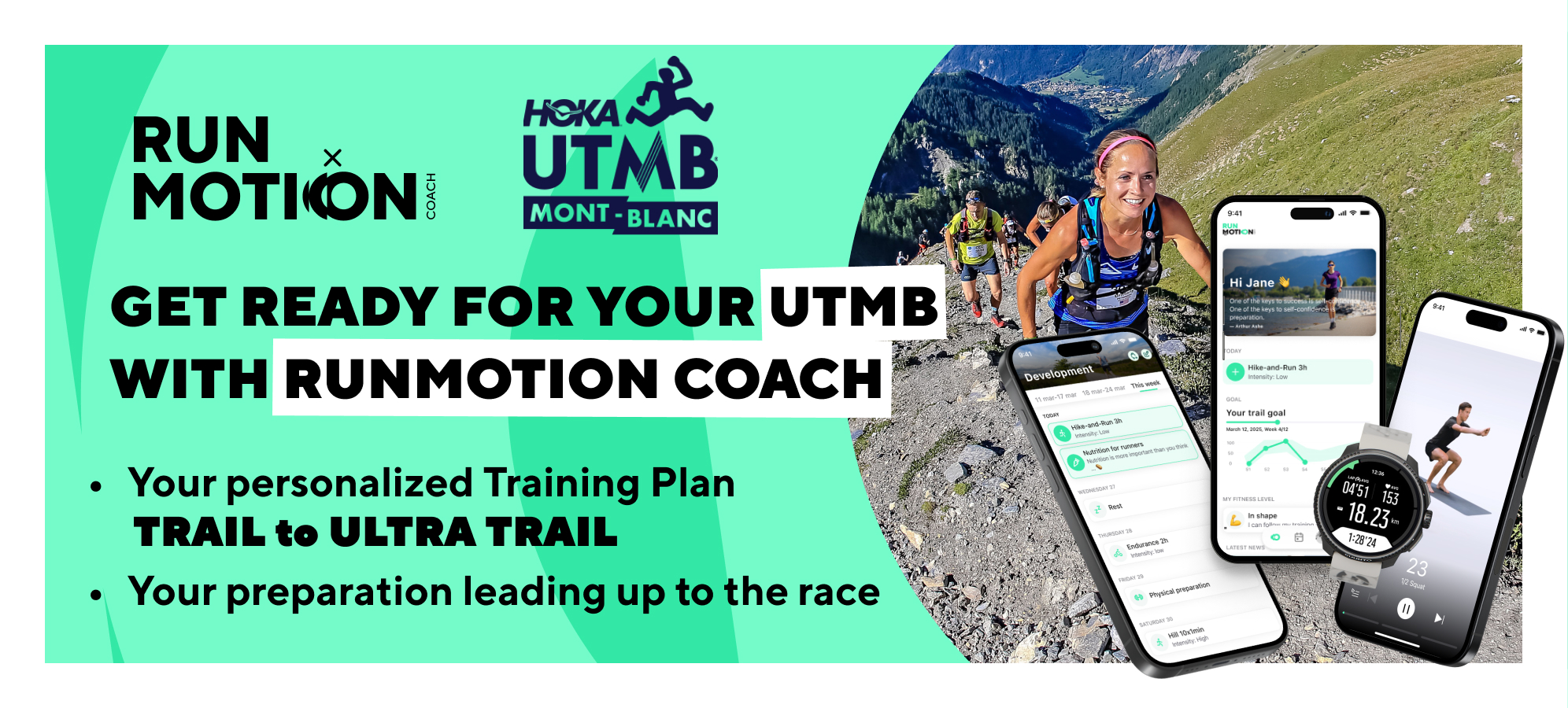
Are you registered for one of the UTMB® Mont-Blanc races at the end of August – the UTMB®, the CCC®, the TDS®, the OCC, the MCC, or the PTL®? RunMotion Coach is the official coach of the UTMB® Mont-Blanc. In this capacity, we provide you with the advice to succeed in this legendary race around Mont-Blanc and maximize your chances of crossing the famous finish arch in Chamonix!
Whether your goal is to set a personal best or simply finish, you need a trail training program that suits you. Below you will find our advice for the flagship UTMB® race (171 km, 10,000 m of elevation gain) as well as for the other races during the week.
Contents
Ensure a Coherent Overall Training Volume
If you want to succeed in your UTMB®, you need a training volume of at least 10 hours per week – ideally even 15 hours if possible. The majority of this volume is built by running. It is essential to train your body to handle the impacts and elevation changes while running.
It is recommended to supplement your overall training volume with cycling, which is excellent for endurance and helps develop leg strength endurance. For variety, you can add ski touring or cross-country skiing in winter and swimming in summer.
For the CCC®, aiming for 8–12 hours of training per week is ideal, whereas for the MCC and the OCC, 5 to 10 hours per week may be sufficient. Of course, this depends on each individual, particularly their past training volume and ambitions. If you wish to increase your training hours compared to last year, make sure to progress gradually.
Do Specific Sessions for an Ultra Trail or the UTMB®
The UTMB® Mont-Blanc races require appropriate training. To prepare, it is important to incorporate varied, specific trail sessions into your training routine.
Trail Hiking Sessions
One of the fundamentals of ultra trail training is the trail hiking session. The pace is similar to that of an ultra. The goal is to accustom your body to alternating between walking and running and to different speeds. Generally, it is not recommended to exceed 5 hours of effort during a trail hike, as the body is already significantly taxed. If you want to build a higher volume, you can eventually supplement with 1 or 2 hours of cycling afterwards.
And to achieve even greater volumes, you can sign up for preparatory races – we will come back to that later.
Hill Sprints
During hill sprint sessions, the focus is on developing strength and running technique with a relatively high movement speed. You can, for example, perform sessions such as 12×30 seconds up to 8×1½ minutes. They may seem short, but the advantage is that they can be run almost anywhere (even in the city if there is a sufficiently long hill) and can easily be fitted into a lunch break. Generally, your heart rate will increase significantly.
Threshold Run Uphill
The threshold run uphill improves your ability to climb a long ascent quickly – for example, between 500 and 1000 m of elevation gain. This type of session builds endurance. You might see sessions like 4×6 minutes or 3×10 minutes.

Downhill Running
Every trail runner knows that it is usually the descents that “break” the legs. A good way to prepare is to specifically train for downhill running, ideally at a faster pace. Initially, you may experience some muscle fiber damage, but over time the muscles will strengthen. For example, you can do up to 10×1 minute of downhill running. The pace is faster than during normal running, and it helps you feel more comfortable during competitions.
Special Physical Preparation for Trail Running
For ultra trail efforts, it is essential to undertake a tailored physical preparation. This includes strength training exercises, such as those found in the Strength & Conditioning Workouts module of the RunMotion Coach app.
Additionally, you can add exercises on a bike or stationary trainer to develop strength and endurance. For instance, you might perform a maximal effort for a short duration (the RunMotion app also offers these exercises if you select one or more cycling days per week) or engage in longer uphill sessions. If you are in the city, stairs can be an excellent way to perform plyometric training.
Plan Preparatory Races Before the UTMB®
To accumulate significant training volume during your preparation, there is nothing better than a race: you benefit from pre-planned aid stations, safety supervision, and you can test your equipment and nutritional strategy. It is, in a way, a dress rehearsal and a chance to gauge your current form.
For example, if you are preparing for the UTMB® or the TDS®, you might plan a trail between 80 and 100 km between May and June (or even early July), or even two 80 km trails spaced one month apart.
If you are preparing for the CCC®, you might aim for a trail of 60–70 km between May and mid-July. For the OCC® and the MCC, running distances of 20 to 42 km up until the end of July might suffice.
Prepare for the Weather Conditions of the UTMB® Mont-Blanc
At the UTMB® Mont-Blanc, the best runners typically spend only one night on the course, arriving on Saturday afternoon. Only a few hundred runners finish in less than 30 hours – that is, before midnight on Saturday. For everyone else, this means spending two nights outdoors.
Therefore, it is important to train for running at night, so that your body becomes accustomed to exertion in the dark and you get familiar with your headlamp. For example, you might train in the evening to experience the sunset and then run back with your headlamp on, or you can set off early in the morning to catch the sunrise!
However, it is not recommended to spend an entire night outdoors during training, as this leads to excessive fatigue. In training, you should only run a few hours at night. You might occasionally do night races as preparation or opt for a very early start.
Half of the TDS® runners also spend a second night outdoors. And the vast majority of CCC® runners finish during the night. Therefore, you need to prepare to run at night.
Also, prepare for cold conditions. The passes on the Tour du Mont-Blanc can reach up to 2500 m in altitude. While this is not true high-mountain terrain, it can be cold at the end of August and it may even snow – especially at night and when it rains. If snow falls, the course may be altered.
Don’t Overdo It in August!
In August, you are entering the “money time” – the final moments of your preparation. If you can still do a few long runs at the beginning of August, reduce your mileage during the last 2–3 weeks.
You do not want to start the race too fatigued or even injured. Beyond physical fatigue, it is important to stay mentally fresh so that you can give your all on race day.
The biggest mistake is to train too hard in the weeks leading up to the race. Even if you wanted to accumulate more volume in your preparation, keep a moderate volume in the final phase.

Take Good Care of Your Recovery
To properly recover from your high training volume, here are some key tips. The three pillars of recovery are sleep, nutrition, and hydration.
The most restorative element for the body is sleep. Aim to sleep at least 7 to 8 hours each night in a quiet environment. During especially intense training weeks, you might even target 9 hours of sleep or add a nap during the intensive training weekend.
After a strenuous training session, eat carbohydrates and proteins within one hour of finishing. During this period, the body can absorb these nutrients more effectively – this is known as the metabolic window. This helps replenish your carbohydrate stores and promotes muscle recovery.
Regarding hydration, it is recommended to drink at least 1.5 liters of water per day, plus an additional 300–500 ml per hour of effort. On your long runs, always carry a water bottle with you.
Massages, compression socks, electrostimulation, and alternating between warm and cold can be useful complementary recovery techniques.

Nutrition Advice for the Week Before the UTMB® Mont-Blanc
The most common reason for dropping out of an Ultra-Trail® is digestive issues. Running places a significant strain on the intestinal walls, as during exercise the heart pumps blood primarily to the most vital organs – namely the brain and the muscles. Consequently, the intestines may receive insufficient blood flow, and repeated impacts can lead to damage of the intestinal lining.
It is therefore best to start with a solid foundation. In the weeks leading up to a race, you might consider a course of L-glutamine and probiotics. L-glutamine is an essential fuel for the cells of the small intestine and aids in the absorption of nutrients – simply put, it strengthens your intestinal walls. Probiotics help maintain a healthy balance in your gut microbiome and promote proper digestion.
When you start one of the UTMB® Mont-Blanc races, it is important to be optimally fueled with carbohydrates. Carbohydrates are the primary fuel during an Ultra-Trail®, and those first aid stations can make all the difference.
It is often advised to reduce (without completely stopping) your carbohydrate intake between 7 and 4 days before the race, as you are still training and your carbohydrate stores are being depleted.
And from 3 to 1 day before the race, focus on high-quality carbohydrate sources: starchy foods, rice, potatoes, bread, rice cakes, honey, maple syrup, etc. Some may opt for gluten-free options. Avoid too much fiber, as it can irritate the intestinal walls. Instead, choose well-ripened fruits such as bananas or cooked fruits like apples, pears, and peaches.
Also, prepare your nutrition and hydration strategy for the race day carefully.
Manage Your Effort During the UTMB®
It’s time – you are ready to take on the UTMB® Mont-Blanc! Above all, this race is an opportunity to learn about yourself and push your limits. Don’t jeopardize your chances by starting too fast. This is one of the most common mistakes: you start a race that lasts many hours, and those few minutes you save at the beginning can cost you dearly at the end.
A good training plan should enable you to be in top form on race day. Listen to your body, enjoy your training, and remember why you started. You have trained for months – if not years – to experience these beautiful trails around Mont-Blanc. Enjoy it!
If you want to maximize your chances of success and need a personalized training plan for the UTMB® Mont-Blanc, you can download the RunMotion Coach app – the official coach of the UTMB® Mont-Blanc.
Enter your experience and your goal for the UTMB® Mont-Blanc: UTMB®, CCC®, TDS®, OCC, MCC, or PTL®. Here you will find all the advice presented, along with further details and a structured training plan. All that is left for you to do is run!
